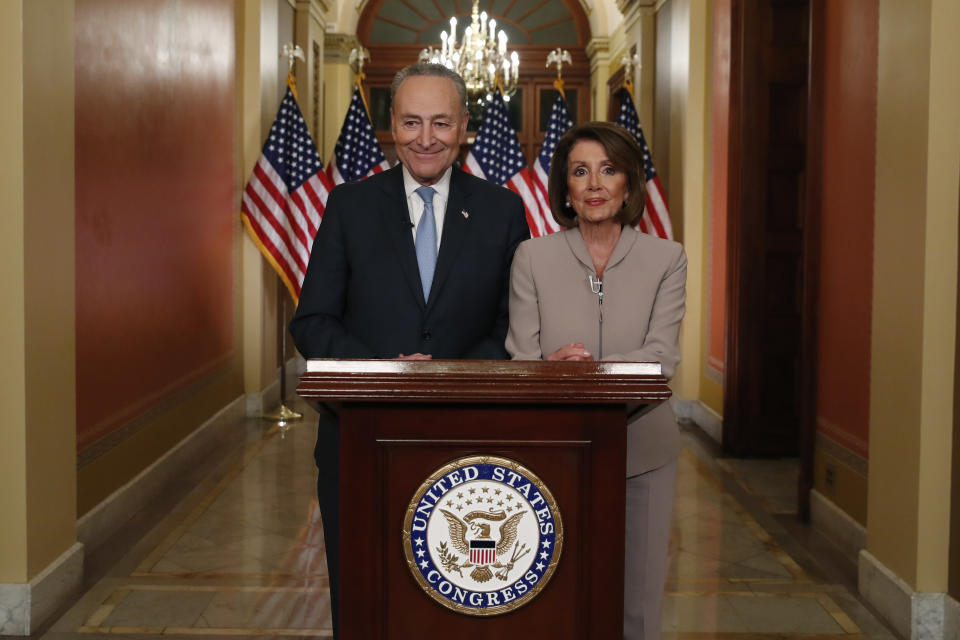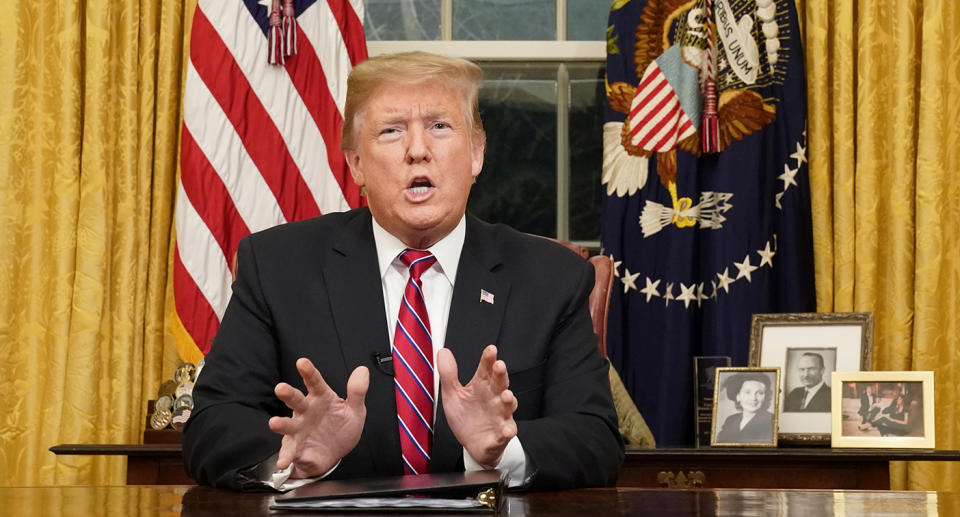With government mostly shut, Trump repeats his demand for a wall
During Tuesday’s primetime address on border security, President Trump had a message for defiant congressional Democrats: Mr. Schumer and Ms. Pelosi, build this wall.
In his first address to the nation delivered from the Oval office, Trump warned of a “growing humanitarian and security crisis at our southern border,” but stopped short of declaring a national emergency to give him authority to start construction on a wall without going through Congress.
Leaks and rumors had fed speculation that a national emergency declaration was in the offing, which would almost certainly have led to legal challenges and a potential Constitutional crisis. But the less-than-10-minute speech basically repeated claims Trump had been making at rallies and in tweets since his campaign began.
Trump said “We are running out of space” to house those who cross the border, and suggested that “among the hardest hit” by ineffective border security and lax immigration laws are African-Americans.
Citing the flow of illegal drugs into the country from Mexico, Trump noted that the number of Americans killed annually exceeds those who died in the Vietnam War. The president said the request for $5.7 billion to build a wall originated with law enforcement officials, and added that Democrats in Congress had asked that the barrier be built of steel.
“At the request of Democrats, it will be a steel barrier rather than a concrete wall,” Trump said, without specifying when such a request had been made or which Democrats had made it. “This barrier is absolutely critical to border security. It’s also what our professionals at the border want and need. This is just common sense.”
Trump also blamed the continuing government shutdown on the refusal of Democrats to approve funds for a wall, despite his declaration last month that he would take responsibility for the impasse.
“Democrats in Congress have refused to recognize the crisis, and they have refused to provide our brave border agents with the tools they desperately need to protect our families and our nation,” Trump said.
The singular sticking point in the nearly three-week-old government shutdown, the wall has been vehemently opposed by Democrats, many of whom view it as ineffective and a waste of money. House Speaker Nancy Pelosi and Senate Minority Leader Chuck Schumer delivered the Democratic response to the president.

Pelosi said the “president has chosen fear” to sell his proposal.
“The fact is on the very first day of this Congress, House Democrats passed Senate Republican legislation to reopen and fund smart, effective border security solutions,” Pelosi said. “But the president is rejecting these bipartisan bills that would reopen government, over his obsession with forcing American taxpayers to waste billions of dollars on an expensive and ineffective wall, a wall he always promised Mexico would pay for.”
Concluding his remarks on Trump’s demand for money for the border wall, Schumer was blunt. “Our suggestion is a simple one. Mr. President, reopen the government, and we can work to resolve our differences on border security. But end this shutdown now.”
The construction of a border wall was Trump’s signature campaign promise during the 2016 presidential campaign, although he insisted that he would make Mexico pay for it. Mexico has made it clear that it has no such intention.
In recent months, the president has shifted to the argument that the economic benefits of the new United States-Mexico-Canada Agreement (USMCA) trade agreement, replacing the North American Free Trade Agreement (NAFTA), will cover the cost of building a wall.
“What we save on the USMCA — the new trade deal we have with Mexico and Canada — what we save on that, just with Mexico, will pay for the wall many times over in just a period of a year, two years and three years,” Trump said at a news conference on Jan. 4, adding, “So I view that as, absolutely, Mexico is paying for the wall.”

Estimates for the cost of constructing a barrier, whether made of concrete or “steel slats,” as Trump has recently been pitching, vary wildly. While the president suggested it might be built for $12 billion, the Department of Homeland Security estimated in February that the wall would cost $20 billion. A report by Senate Democrats issued in 2017 put the total at $70 billion. The disparity stems in part from confusion over how much territory the wall will cover. The entire Mexico-U.S. border, parts of which already have barriers in place, runs for 2,000 miles.
In the run-up to the 2018 midterm elections, which cost his party control of the U.S. House of Representatives, Trump sought to make border security a top issue. He seized on news that a migrant caravan from Central America was walking to the border to seek asylum as justification for construction of a wall, and eventually deployed 5,200 active duty troops from the U.S. military to deter them.
The Caravans are made up of some very tough fighters and people. Fought back hard and viciously against Mexico at Northern Border before breaking through. Mexican soldiers hurt, were unable, or unwilling to stop Caravan. Should stop them before they reach our Border, but won’t!
— Donald J. Trump (@realDonaldTrump) October 31, 2018
Trump will follow up Tuesday’s speech by attending Senate Republicans’ weekly policy luncheon on Wednesday. Afterward, the president and the Republican and Democratic leaders in the House and Senate are scheduled to return to the White House to try to hammer out an end to the shutdown, but neither side appears eager to offer compromises.
On Thursday, the president will continue his public relations offensive, traveling “to the southern border,” White House Press Secretary Sarah Sanders said in a tweet, “to meet with those on the frontlines of the national security and humanitarian crisis.”
_____
Read more from Yahoo News:



